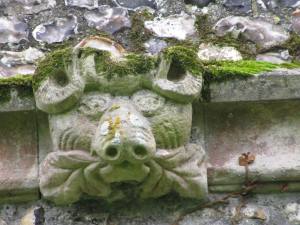Having had a meeting today with Drs Martin Watts and John Bulaitis regarding the feasibility of putting on a one-day conference on the development of Richborough, especially its role as a gateway both into and out of Kent, and England, to/from continental Europe, I thought I would pass on the news to readers. Martin and John’s primary interest in the place rests on its 20th-century history, and both are keen to provide lectures from their recent research findings. As a consequence it is envisaged at this planning stage that the talks in the afternoon will feature episodes from the port’s Great War and subsequent history, while the morning will focus on its Roman, Anglo-Saxon and medieval past. In addition to lectures from staff at Canterbury Christ Church, the intention is to involve experts from east Kent, particularly field archaeologists from the region who have first-hand knowledge of the area. More on this anon as things develop, but a provisional date for this conference is late May or early June in 2016.
John and I also had a chance to discuss his research on the tithe wars in Kent in the early 1930s. John is just finishing off another project, but hopes to get back to the tithe battles in the New Year. He has undertaken a considerable amount of research so far – witness his Nightingale lecture – but now needs the time to undertake a systematic study not just in Kent. For, as he said, there were comparable disputes in East Anglia, Wales and the south-west, including Devon and Somerset. As noted in an earlier blog, John has been in contact with Dr Paula Simpson who worked on 16th-century tithe disputes in Kent for her doctorate, and together they will hopefully form the core of another conference under the Centre’s banner, also in 2016, perhaps in the late summer.

Photo: Imogen Corrigan
Together with the Medieval Canterbury Weekend, the Centre’s activities are growing, and it would be great to extend this. In part Martin’s research on Richborough’s importance in the Great War will be one outcome from the Centre, and it would be great to be able to extend this further through additional research projects, not least because the county has rich archival and archaeological resources. Indeed Early Medieval Kent, 800–1220, which is the final book in the Kent History Project series, will highlight these twin resources because the collection contains essays by both historians and archaeologists. The volume, to be published by Boydell, is coming along well and the cover has now been finalised. The text has got to the copy editor stage and I expect to have flyers detailing a special offer for the book at the Medieval Canterbury Weekend – a major achievement!
Moreover, to underline the vitality of history and archaeology in Kent, I thought I would devote the remainder of the blog to the Kent Archaeological Society Fieldwork Committee’s 1-day conference on ‘Anglo-Saxon Kent: old and new discoveries’ that took place at the University of Kent last Saturday. This featured archaeologists from Thanet Archaeology, Canterbury Archaeological Trust and the University of Reading. Regarding the latter, Dr Gabor Thomas’ Lyminge project has now reached the post-excavation phase and, as he indicated, he is now grappling with trying to sort out what the excavations can tell us about the 5th to 8th centuries, not only in Kent but across England and the North Sea lands more generally. The ideas he is seeking to discuss revolve around power and the culture of kingship, including the role of the royal vills. These core sites with their outlying economic resources such as the dens – sources of woodland pasture, timber and fuel – were locations where royal power could be exercised, and, just as importantly, seen to be exercised within a developed military, political and economic infra-structure. As Gabor noted, Lyminge with its succession of royal halls, its industrial activities, its monastic centre and its environmental deposits will provide vital clues about this complex and dynamic society.
This theme of just how important the 5th to 8th centuries are in the history of the kingdom of Kent had also been discussed by Dr Andrew Richardson and Keith Parfitt. The former looking first at the development of jewellery across the region and the significance of particular outside influences, especially the North Sea coastal zone and the Frankish kingdom; and then at the importance of Faversham as a metal-working centre. Keith, too, drew on evidence from material culture – brooches, pottery and glass vessels, but he also considered the landscape, especially the Anglo-Saxon settlements further up the Dour valley to the north of Dover. And this stress on the need to understand the landscape was brought home by Ges Moody through his consideration of where it is likely that Augustine landed in 597, and where he subsequently met the royal delegation under King Ethelbert. His approach of borrowing from historical geography and the need to consider the presence of a shingle barrier, as well as the Deal shingle spit, in any meaningful investigation of Augustine’s first landfall and his meeting on Thanet with the king was thoughtfully done, thereby engaging his audience. Thus the day was a fascinating exploration of Kent’s Anglo-Saxon past, and it is great that both universities are facilitating the dissemination of knowledge in this way.
 Centre for Kent History and Heritage
Centre for Kent History and Heritage Matthew Crockatt
Matthew Crockatt 720
720

